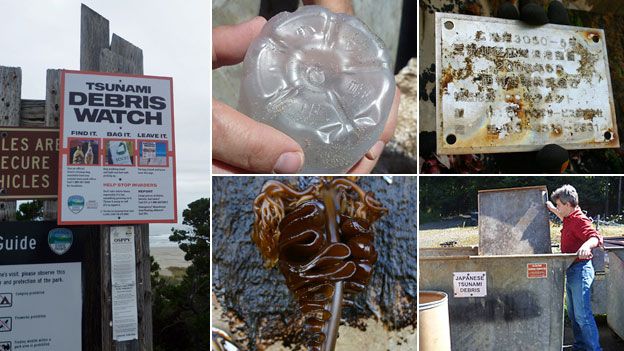The tsunami debris washed from Japan to Oregon
- Published

Debris from last year's Japanese tsunami has already started landing on the West coast of the United States, and people living in Oregon are bracing themselves for more in the next few weeks, when the winter storms begin.
The early mist over Yaquina Bay in Oregon is beginning to burn off as 25 volunteers gather to clean up the beach. The wind shapes the sand into dunes and debris can often be found collected at the base of these.
A dozen college students have joined pensioners, surfers and locals keen to keep the beach clear of all rubbish - but they are aware more debris from Japan is on its way.
"As far as what will come - that part scares me," says Sandy Hayden, who lives in the nearby fishing town of Newport.
"I've walked the beaches and see the trash that washes up anyway in the winter time so I have no idea what this winter will bring - but I just hope that there are a lot who will volunteer to clean it up."
Hayden is collecting pieces of polystyrene which have blown in and broken up. She puts them in a plastic sack along with bits of fishing rope, rubber and bottles. It's hard to say where it all originated, or when. But as time goes on, an increasing proportion of the rubbish will come from Japan.
It had initially been estimated the tsunami debris would hit land on the west coast of North America in 2013 but items started washing up in April this year, beaching in Alaska, British Columbia, Washington and Oregon. They are just starting to reach California now.
Volunteer beachcombers, who work alongside State Parks officers, are given gloves to protect their hands. There has been no evidence yet of any radioactive debris, but anyone who finds flotsam on the beach can alert the rangers if they do not want to touch it themselves.
In Oregon, 32 large bins have been placed along the coast as tsunami rubbish drop-off points.
Hayden says the volunteers are sensitive to what the debris is.
"It's a reminder of what happened, so it's not just trash. It was people's belongings and people's livelihoods and people's homes," she says.
More than 15,000 people died in the tsunami. The images of whole villages being dragged into the ocean remain vivid in the minds of anyone who saw them.
Thousands were drawn to Agate beach, Newport, when a 66ft (20m) concrete dock, kept buoyant by polystyrene, arrived intact in June.
"They all reacted in different ways," says Chris Havel of Oregon Parks and Recreation Service. "Many of them just walked up and touched it - without saying a word they were making contact with it... and after we confirmed it was from Japan the attitudes deepened. People were making this emotional connection with this horrible tragedy."
The bulk of the debris field is still currently north of Hawaii with the front edge starting reaching the West Coast, so much larger amounts are expected over the next year or so. That is a rough estimate.
"We can make these predictions about ocean currents but we've really got to get our eyes out there and see what's out there," says Jack Barth, an oceanography professor at Oregon State University's College of Oceanic and Atmospheric Sciences.
"If it's a bunch of wood just from houses I don't see that as a big worry, but imagine larger pieces of houses if it was able to survive all the way across. There's obviously personal effects and we want to be watching out for those because it'll provide some closure for those families back in Japan."
This has already happened.
A football and volleyball washed up on Middleton Island, Gulf of Alaska, with names written on them, allowing beachcombers David and Yumi Baxter to trace the teenage owners and send them back.
When a container with a Harley Davidson motorcycle in it washed up on a beach in British Columbia, a Japanese person saw it in the press and helped locate its owner via the registration plate.
Despite the 5,000 miles of ocean between them, there is another connection that Oregonians have with Japan - a shared geology.
Signs at Yaquina beach warn of the tsunami risk here too. The coast has a history of significant earthquakes that in the past have caused giant waves, but that was before there were large settlements here.
The next one that strikes will leave them "susceptible to the same sort of tragedy that struck Japan", Mr Havel says.
"This dock, it shook loose from the west coast of Japan, travelled 5,000 miles across the ocean and delivered a message in a bottle to the people of Oregon saying: 'This will be you - we don't know when or how big it's going to be or exactly what will happen but this will be you. Understand that, prepare for it, but really accept the fact you live on the Pacific coast and there's a cost to doing that.'"